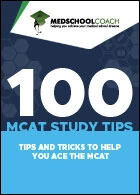
In 2022-2023, the average science GPA of matriculants was 3.68, while the overall GPA was 3.75. On the other hand, applicants had an average science GPA of 3.52 and overall GPA of 3.62.
Table of Contents
The minimum GPA for most med schools is 3.0. But if you’re a pre-med student, you’ll need to aim for a GPA of 3.6 or higher to compete with other applicants.
Not all medical schools require a certain minimum GPA to apply. But the minimum cutoff GPA is absolutely irrelevant because your GPA needs to be competitive for the particular school that you are applying to. A competitive GPA and the minimum GPA required to apply to that school are usually much different.
When it comes to the medical school admissions process, grade point average is often one of the first things that admissions officers and the admissions committee look at.
The sheer volume of medical school applications they receive means that an applicant’s GPA can be a critical factor for screening. But what does a competitive GPA for medical school look like?
Our Calculator uses a combo of your GPA, MCAT score, and various factors about your undergraduate studies to determine how competitive your med school application will be.
What is a competitive GPA for medical school?
A competitive GPA for medical school is generally 3.6 or higher.
On average, successful matriculants — students who are accepted and enroll — have higher GPAs than other applicants.
According to the Association of American Medical Colleges (AAMC), the average GPAs and MCAT scores for medical school applicants and matriculants in the 2022-2023 academic year were:
| Average Science GPA | Average Non-Science GPA | Average Overall GPA | Average MCAT Score | |
| Applicants | 3.52 | 3.76 | 3.62 | 506.5 |
| Matriculants | 3.68 | 3.84 | 3.75 | 511.9 |
These averages provide a good benchmark for what medical schools consider competitive.
However, remember that these are averages; they include GPAs from applicants and matriculants from all MD programs across the country. Admissions requirements vary from school to school, but the cutoff is typically around the 3.0 mark to be considered.
Some top-tier schools of medicine may have even higher average GPAs, and these schools may use national GPA averages as cutoffs for initial selection. Because of the competitiveness of the application process, you’d typically need a GPA that’s higher than the national average.
You can access more med school admissions statistics at AAMC, as well as look into individual schools’ admissions requirements using the MSAR.
Average GPA and MCAT Score By School
| Medical School | State | Degree Type | Average GPA | Average MCAT | Minimum MCAT |
|---|---|---|---|---|---|
| University of Alabama School of Medicine | AL | MD | 3.8 | 509.2 | 494 |
| University of South Alabama College of Medicine | AL | MD | 3.83 | 510 | NR |
| Alabama College of Osteopathic Medicine | AL | DO | 3.47 | 505 | NR |
| Edward Via College of Osteopathic Medicine – Auburn Campus | AL | DO | 3.67 | 502 | 494 |
| University of Arkansas for Medical Sciences College of Medicine | AR | MD | 3.81 | 509 | NR |
| Arkansas College of Osteopathic Medicine | AR | DO | 3.5+ | 500+ | NR |
| University of Arizona College of Medicine – Tucson | AZ | MD | 3.74 | 508 | 498 |
| University of Arizona School of Medicine – Phoenix | AZ | MD | 3.77 | 515 | 495 |
| Mayo Clinic Alix School of Medicine | AZ | MD | 3.94 | 521 | NR |
| A.T. Still University | AZ | DO | 3.45 | 505 | NR |
| Arizona College of Osteopathic Medicine of Midwestern University | AZ | DO | 3.53 | 507 | NR |
| California Northstate University College of Medicine | CA | MD | 3.6 | 511 | 497 |
| California University of Science and Medicine | CA | MD | 3.61 | 513 | NR |
| Drew/UCLA Joint Medical Program Drew University of Medicine and Science | CA | MD | 3.42 | NR | NR |
| Loma Linda University School of Medicine | CA | MD | 3.83 | 509 | NR |
| University of California – Davis School of Medicine | CA | MD | 3.58 | 509 | NR |
| Stanford University School of Medicine | CA | MD | 3.89 | 518 | NR |
| University of California – Irvine School of Medicine | CA | MD | 3.78 | 514.2 | NR |
| University of California – Los Angeles David Geffen School of Medicine | CA | MD | 3.81 | 516 | NR |
| University of California – Riverside School of Medicine | CA | MD | 3.6 | 509 | NR |
| University of California – San Diego School of Medicine | CA | MD | 3.77 | 515.11 | NR |
| University of California – San Francisco School of Medicine | CA | MD | 3.87 | 517 | NR |
| University of Southern California Keck School of Medicine | CA | MD | 3.8 | 517 | NR |
| Kaiser Permanente School of Medicine | CA | MD | 3.76 | 516 | NR |
| Touro University California College of Osteopathic Medicine | CA | DO | 3.56 | 509 | NR |
| Western University of Heath Sciences College of Osteopathic Medicine of the Pacific | CA | DO | 3.66 | 508 | NR |
| California Health Sciences University College of Osteopathic Medicine | CA | DO | 3.48 | 506 | 498 |
| University of Colorado School of Medicine | CO | MD | 3.82 | 516 | NR |
| Rocky Vista University College of Osteopathic Medicine | CO | DO | 3.54 | 504.4 | NR |
| Quinnipiac University Frank H. Netter MD School of Medicine | CT | MD | 3.7 | 513 | NR |
| University of Connecticut School of Medicine | CT | MD | 3.76 | 513 | NR |
| Yale School of Medicine | CT | MD | 3.87 | 519 | NR |
| George Washington University School of Medicine and Health Sciences | DC | MD | 3.7 | 512 | NR |
| Georgetown University School of Medicine | DC | MD | 3.7 | 512 | NR |
| Howard University College of Medicine | DC | MD | 3.61 | 507 | 494 |
| Florida Atlantic University Charles E. Schmidt College of Medicine | FL | MD | 3.79 | 513 | NR |
| Florida International University Herbert Wertheim College of Medicine | FL | MD | 3.76 | 509 | NR |
| Florida State University College of Medicine | FL | MD | 3.8 | 507 | 498 |
| University of Central Florida College of Medicine | FL | MD | 3.84 | 515 | 500 |
| University of Florida College of Medicine | FL | MD | 3.79 | 514 | 500 |
| University of Miami Miller School of Medicine | FL | MD | 3.75 | 514 | NR |
| University of South Florida Health Morsani College of Medicine | FL | MD | 3.89 | 517 | NR |
| Lake Erie College of Osteopathic Medicine Bradenton Campus | FL | DO | 3.47 | 503 | NR |
| Nova Southeastern University Dr. Kiran C. Patel College of Allopathic Medicine | FL | MD | 3.76 | 512 | NR |
| Nova Southeastern University Dr. Kiran C. Patel College of Osteopathic Medicine | FL | DO | 3.6 | 506 | NR |
| Emory University School of Medicine | GA | MD | 3.7 | 514 | NR |
| Medical College of Georgia at Augusta University | GA | MD | 3.8 | 513 | NR |
| Mercer University School of Medicine | GA | MD | 3.66 | 504 | 493–494 |
| Morehouse School of Medicine | GA | MD | 3.68 | 506 | NR |
| Georgia Campus Philadelphia College of Osteopathic Medicine | GA | DO | NR | 503.9 | NR |
| University of Hawaii John A. Burns School of Medicine | HI | MD | 3.74 | 512 | NR |
| University of Iowa Carver College of Medicine | IA | MD | 3.79 | 513 | NR |
| Des Moines University College of Osteopathic Medicine | IA | DO | 3.44 | 495 | NR |
| Idaho College of Osteopathic Medicine | ID | DO | 3.57 | 507 | 501 |
| Carle Illinois College of Medicine | IL | MD | 3.73 | 513 | 498 |
| Chicago Medical School at Rosalind Franklin University of Medicine and Science | IL | MD | 3.69 | 511 | 510 |
| Loyola University of Chicago Stritch School of Medicine | IL | MD | 3.7 | 510 | NR |
| Northwestern University The Feinberg School of Medicine | IL | MD | 3.9 | 520 | NR |
| Rush Medical College of Rush University | IL | MD | 3.57 | 510 | NR |
| Southern Illinois University School of Medicine | IL | MD | 3.82 | 508 | 498 |
| University of Chicago Pritzker School of Medicine | IL | MD | 3.87 | 519 | NR |
| University of Illinois College of Medicine | IL | MD | 3.8 | 513 | NR |
| Chicago College of Osteopathic Medicine of Midwestern University | IL | DO | 3.7 | 510 | NR |
| Indiana University School of Medicine | IN | MD | 3.83 | 512.1 | NR |
| Marian University College of Osteopathic Medicine | IN | DO | 3.71 | 504 | 491 |
| University of Kansas School of Medicine | KS | MD | 3.88 | 509 | NR |
| Kansas College of Osteopathic Medicine | KS | DO | 3.0 Minimum for consideration | NR | 500 |
| University of Kentucky College of Medicine | KY | MD | 3.78 | 506 | 495 |
| University of Louisville School of Medicine | KY | MD | 3.68 | 507 | NR |
| University of Pikeville Kentucky College of Osteopathic Medicine | KY | DO | 3.5 | 500 | NR |
| Louisiana State University – New Orleans School of Medicine | LA | MD | 3.73 | 509 | NR |
| Louisiana State University – Shreveport School of Medicine | LA | MD | 3.7 | 507 | NR |
| Tulane University School of Medicine | LA | MD | 3.58 | 510 | NR |
| Edward Via College of Osteopathic Medicine – Louisiana Campus | LA | DO | 3.7 | 502 | 496 |
| Boston University School of Medicine | MA | MD | 3.72 | 517 | NR |
| Harvard Medical School | MA | MD | 3.9 | 520.06 | NR |
| Tufts University School of Medicine | MA | MD | 3.74 | 514 | NR |
| University of Massachusetts Medical School | MA | MD | 3.76 | 515 | NR |
| Johns Hopkins University School of Medicine | MD | MD | 3.94 | 521 | NR |
| Uniformed Services University of the Health Sciences F. Edward Hebert School of Medicine | MD | MD | 3.7 | 511 | 496 |
| University of Maryland School of Medicine | MD | MD | 3.8 | 515 | NR |
| University of New England College of Osteopathic Medicine | ME | DO | 3.61 | 505 | 490 |
| Central Michigan University College of Medicine | MI | MD | 3.69 | 508 | NR |
| Michigan State University College of Human Medicine | MI | MD | 3.77 | 510 | NR |
| Oakland University William Beaumont School of Medicine | MI | MD | 3.84 | 510 | NR |
| University of Michigan Medical School | MI | MD | 3.8 | 515 | NR |
| Wayne State University School of Medicine | MI | MD | 3.8 | 514 | NR |
| Western Michigan University School of Medicine | MI | MD | 3.77 | 513 | 497 |
| Michigan State University College of Osteopathic Medicine | MI | DO | 3.50–3.70 | 506–508 | NR |
| Mayo Clinic Alix School of Medicine | MN | MD | 3.94 | 521 | NR |
| University of Minnesota Medical School – Twin Cities | MN | MD | 3.7 | 511 | NR |
| University of Minnesota Medical School – Duluth | MN | MD | 3.7 | 508 | NR |
| University of Missouri – Columbia School of Medicine | MO | MD | 3.77 | 508 | 494 |
| Saint Louis University School of Medicine | MO | MD | 3.85 | 510.63 | NR |
| University of Missouri – Kansas City School of Medicine | MO | MD | 3.85 | 510 | 500 |
| Washington University School of Medicine | MO | MD | 3.86 | 520.2 | NR |
| A.T. Still University of Health Sciences Kirksville College of Osteopathic Medicine | MO | DO | 3.72 | 503 | NR |
| Kansas City University of Medicine and Biosciences College of Osteopathic Medicine | MO | DO | 3.62 | 505 | NR |
| University of Mississippi School of Medicine | MS | MD | 3.7 | 504 | 496 |
| William Carey University College of Osteopathic Medicine | MS | DO | 3.53 | 505 | NR |
| Duke University School of Medicine | NC | MD | 3.9 | 519 | NR |
| East Carolina University Brody School of Medicine | NC | MD | 3.58 | 507 | NR |
| University of North Carolina at Chapel Hill School of Medicine | NC | MD | 3.76 | 512 | NR |
| Wake Forest School of Medicine | NC | MD | 3.76 | 511 | NR |
| Campbell University Jerry M. Wallace School of Osteopathic Medicine | NC | DO | 3.66 | 507 | NR |
| University of North Dakota School of Medicine and Health Sciences | ND | MD | 3.8 | 507 | NR |
| Creighton University School of Medicine | NE | MD | 3.83 | 513 | NR |
| University of Nebraska Medical Center College of Medicine | NE | MD | 3.82 | 511 | NR |
| Geisel School of Medicine at Dartmouth | NH | MD | 3.77 | 516 | NR |
| Cooper Medical School of Rowan University | NJ | MD | 3.77 | 511 | NR |
| Rutgers New Jersey Medical School | NJ | MD | 3.7 | 514 | NR |
| Rutgers Robert Wood Johnson Medical School | NJ | MD | 3.7 | 512 | NR |
| Hackensack Meridian School of Medicine | NJ | MD | 3.71 | 513 | NR |
| Rowan University School of Osteopathic Medicine | NJ | DO | 3.65 | 506 | NR |
| University of New Mexico School of Medicine | NM | MD | 3.72 | 507 | 494 |
| Burrell College of Osteopathic Medicine at New Mexico State University | NM | DO | 3.7 | 502.1 | 493 |
| University of Nevada Reno School of Medicine | NV | MD | 3.77 | 509 | 500 |
| University of Nevada Las Vegas School of Medicine | NV | MD | 3.6–3.7 | 510 | NR |
| Touro University – Nevada College of Osteopathic Medicine | NV | DO | 3.54 | 506.9 | 500 |
| Albany Medical College | NY | MD | 3.6 | 511 | NR |
| Albert Einstein College of Medicine | NY | MD | 3.82 | 516 | NR |
| Columbia University College of Physicians and Surgeons | NY | MD | 3.9 | 522 | NR |
| Hofstra Northwell School of Medicine | NY | MD | 3.85 | 518 | NR |
| Icahn School of Medicine at Mount Sinai | NY | MD | 3.81 | 519 | NR |
| New York Medical College | NY | MD | 3.6 | 514 | NR |
| New York University Grossman School of Medicine | NY | MD | 3.92 | 522 | NR |
| New York University Long Island School of Medicine | NY | MD | 3.8 | 516 | NR |
| SUNY – Downstate Medical Center College of Medicine | NY | MD | 3.73 | 513 | NR |
| University at Buffalo Jacobs School of Medicine and Biomedical Sciences | NY | MD | 3.58 | 507 | NR |
| SUNY – Upstate Medical University | NY | MD | 3.64 | 509.86 | NR |
| Stony Brook University School of Medicine | NY | MD | 3.79 | 515.6 | NR |
| University of Rochester School of Medicine and Dentistry | NY | MD | 3.8 | 516 | NR |
| Weill Cornell Medical College | NY | MD | 3.9 | 519 | NR |
| New York Institute of Technology College of Osteopathic Medicine | NY | DO | 3.62 | 506 | NR |
| Touro College of Osteopathic Medicine – Middletown Campus | NY | DO | 3.48 | 502.68 | 498 |
| Touro College of Osteopathic Medicine – Harlem Campus | NY | DO | 3.47 | 506.75 | 498 |
| Case Western Reserve University School of Medicine | OH | MD | 3.82 | 518 | NR |
| Northeast Ohio Medical University | OH | MD | 3.68 | 510 | NR |
| The Ohio State University College of Medicine | OH | MD | 3.81 | 514 | NR |
| The University of Toledo College of Medicine and Life Sciences | OH | MD | 3.72 | 509 | NR |
| University of Cincinnati College of Medicine | OH | MD | 3.78 | 516 | NR |
| Wright State University Boonshoft School of Medicine | OH | MD | 3.7 | 507 | NR |
| Ohio University Heritage College of Osteopathic Medicine | OH | DO | 3.68 | 504.5 | NR |
| University of Oklahoma College of Medicine | OK | MD | 3.81 | 508 | 492 |
| Oklahoma State University Center for Health Sciences College of Osteopathic Medicine | OK | DO | 3.6 | 500 | 492 |
| Oregon Health & Science University School of Medicine | OR | MD | 3.65 | 509 | 497 |
| Drexel University College of Medicine | PA | MD | 3.66 | 511 | NR |
| Geisinger Commonwealth School of Medicine | PA | MD | 3.75 | 511.62 | NR |
| Pennsylvania State University College of Medicine | PA | MD | 3.75 | 511 | NR |
| Perelman School of Medicine University of Pennsylvania | PA | MD | 3.92 | 521.7 | NR |
| Sidney Kimmel Medical College at Thomas Jefferson University | PA | MD | 3.73 | 514 | NR |
| Temple University Lewis Katz School of Medicine | PA | MD | 3.74 | 512 | NR |
| University of Pittsburgh School of Medicine | PA | MD | 3.88 | 517 | NR |
| Lake Erie College of Osteopathic Medicine | PA | DO | 3.41 | 503 | NR |
| Philadelphia College of Osteopathic Medicine | PA | DO | 3.5 | 504.45 | NR |
| Ponce School of Medicine and Health Sciences | PR | MD | 3.5 | 499 | 494 |
| San Juan Bautista School of Medicine | PR | MD | 3.71 | 500 | 492 |
| Universidad Central Del Caribe School of Medicine | PR | MD | 3.8 | 501 | 495 |
| University of Puerto Rico School of Medicine | PR | MD | 3.86 | 506 | 495 |
| Brown University The Warren Alpert Medical School | RI | MD | 3.83 | 516 | NR |
| Medical University of South Carolina College of Medicine | SC | MD | 3.77 | 511 | 496 |
| University of South Carolina School of Medicine – Columbia | SC | MD | 3.7 | 508 | NR |
| University of South Carolina School of Medicine – Greenville | SC | MD | 3.7–3.75 | 509 | NR |
| Edward Via College of Osteopathic Medicine – Carolinas Campus | SC | DO | 3.7 | 500-506 | 496 |
| University of South Dakota Sanford School of Medicine | SD | MD | 3.82 | 508 | 496 |
| East Tennessee State University Quillen College of Medicine | TN | MD | 3.78 | 510.74 | NR |
| Meharry Medical College School of Medicine | TN | MD | 3.46 | 503 | NR |
| University of Tennessee Health Science Center College of Medicine | TN | MD | 3.61 | 512 | NR |
| Vanderbilt University School of Medicine | TN | MD | 3.5-4.0 | 509-528 | NR |
| Lincoln Memorial University DeBusk College of Osteopathic Medicine | TN | DO | 3.5 | 501 | NR |
| Baylor College of Medicine | TX | MD | 3.92 | 518 | NR |
| TCU and UNTHSC School of Medicine | TX | MD | 3.66 | 509 | NR |
| Texas A&M Health Science Center College of Medicine | TX | MD | 3.86 | 513 | NR |
| Texas Tech University Health Sciences Center Paul L. Foster School of Medicine | TX | MD | 3.8 | 509 | NR |
| Texas Tech University Health Sciences Center School of Medicine – Lubbock | TX | MD | 3.9 | 512 | NR |
| University of Houston College of Medicine | TX | MD | 3.59 | 506 | NR |
| University of Texas at Austin Dell Medical School | TX | MD | 3.78 | 514 | NR |
| University of Texas Medical Branch School of Medicine | TX | MD | 3.8 | 511 | NR |
| University of Texas McGovern Medical School at Houston | TX | MD | 3.84 | 512 | NR |
| University of Texas Rio Grande Valley School of Medicine | TX | MD | 3.69 | 508 | 495 |
| University of Texas School of Medicine at San Antonio | TX | MD | 3.86 | 517.64 | NR |
| University of Texas Southwestern Medical School | TX | MD | 3.83 | 517 | NR |
| Sam Houston State University College of Osteopathic Medicine | TX | DO | 3.65 | 506 | NR |
| University of the Incarnate Word School of Osteopathic Medicine | TX | DO | 3.6 | 503 | NR |
| University of North Texas Health Science Center at Fort Worth Texas College of Osteopathic Medicine | TX | DO | 3.81 | 508.7 | NR |
| University of Utah School of Medicine | UT | MD | 3.87 | 514 | 500 |
| Noorda College of Osteopathic Medicine | UT | DO | 3.47 | 504 | 500 |
| Eastern Virginia Medical School | VA | MD | 3.5 | 513 | NR |
| Virginia Commonwealth University School of Medicine | VA | MD | 3.7 | 512 | NR |
| Virginia Tech Carilion School of Medicine and Research Institute | VA | MD | 3.6 | 512 | NR |
| University of Virginia School of Medicine | VA | MD | 3.87 | 518.41 | NR |
| Edward Via College of Osteopathic Medicine – Virginia Campus | VA | DO | 3.7 | 502 | 494 |
| Liberty University College of Osteopathic Medicine | VA | DO | 3.4 | 504 | 501 |
| The University of Vermont Larner College of Medicine | VT | MD | 3.7 | 511 | NR |
| University of Washington School of Medicine | WA | MD | 3.75 | 511 | NR |
| Washington State University Elson S. Floyd College of Medicine | WA | MD | 3.59 | 507.5 | NR |
| Pacific Northwestern University of Health Sciences College of Osteopathic Medicine | WA | DO | 3.6 | 504 | NR |
| Marshall University Joan C. Edwards School of Medicine | WV | MD | 3.66 | 503 | 496 |
| West Virginia University School of Medicine | WV | MD | 3.8 | 511 | NR |
| West Virginia School of Osteopathic Medicine | WV | DO | 3.53 | 504 | 495 |
| Medical College of Wisconsin | WI | MD | 3.75 | 511 | NR |
| University of Wisconsin School of Medicine and Public Health | WI | MD | 3.69 | 511 | NR |
What is included in the GPA used on your medical school application?
Your GPA for medical school application purposes consists of your science GPA, non-science GPA, and your cumulative GPA.
Your science GPA is based on grades from medical school prerequisite courses like biology, chemistry, physics, and math, often referred to as “BCPM” (Biology, Chemistry, Physics, Mathematics) by the AMCAS. Your non-science GPA is based on grades from all other courses.
While the overall GPA provides a general idea of your academic performance, your science GPA specifically reflects how capable you are in the health sciences, which is particularly important to admissions committees.
Learn more about acceptance rates and your chances of getting into your preferred school with our chance predictor.
How to Get into Med School with a Lower GPA
Getting into medical school with a lower GPA is possible, but you’ll probably need to put in extra work to stand out as an applicant. The good news is that applicants who fall below national GPA averages can still be accepted if they excel in other components of their applications.
Medical schools understand that each applicant is unique. That’s why they take subjective aspects of an application into account, like your extracurricular involvement, research experience, and personal qualities.
Here are 6 strategies to get into med school if you have a less-than-stellar GPA.
1. Focus on extracurriculars.
Medical schools value well-rounded applicants who demonstrate a commitment to the field of healthcare. Engage in meaningful extracurricular activities such as clinical experience, volunteer work in hospitals or clinics, participation in research projects, and community service.
Physician shadowing is another great option to gain on-site experience in the specialties you’re interested in. Aim for 100-150 shadowing hours if possible.
These experiences can showcase your dedication, passion, and unique qualities beyond your GPA. Leadership positions or active involvement in student organizations can also illustrate your teamwork and management skills, which are highly valued in the healthcare industry.
2. Get a high MCAT score.
A good MCAT score can counterbalance a low GPA. Getting a high score on this standardized test will prove to the admissions committee that you’re capable of handling the academic rigor of medical school, despite your lower-than-average GPA.
The average MCAT score for matriculants in the 2022-2023 year was 511.9 — and it keeps going up. For now, that’s the score to beat if your GPA is less than impressive. Be sure to prepare thoroughly, using resources like MCAT prep courses, practice tests, and studying the coursework extensively.
If you know you’re likely to struggle with the MCAT, hire a tutor before your first test attempt. You can certainly retake the exam, but several do-overs may give a negative impression to admissions committees.
Want your best shot at acing the MCAT and getting into your preferred school? Learn more about how we can help you boost your MCAT score.
3. Submit glowing letters of recommendation.
Strong letters of recommendation can provide a holistic perspective of your capabilities and potential as a future physician.
Cultivate relationships with professors, healthcare professionals, and mentors who can speak to your academic abilities, personal qualities, and dedication to the field. Choose recommenders who know you well and can provide meaningful insights into your strengths.
4. Write a strong personal statement.
Your medical school personal statement is your chance to tell your story, share your motivations for pursuing medicine, and highlight experiences that shaped you. It’s a unique opportunity to connect with the admissions committee on a personal level and make a lasting impression.
Make sure your essay is well-crafted, sincere, and reflects your commitment to becoming a medical professional. The best personal statements use storytelling to communicate why you’re pursuing this career and point to your passions and soft skills that can’t be defined by a test.
5. Prepare for med school interviews.
If you receive an interview invitation, make sure to thoroughly prepare.
Research the medical school, practice answering common interview questions, and reflect on your experiences and goals. Present yourself confidently, articulately, and passionately during the interview to demonstrate your potential as a medical student.
Interviews are an opportunity to show your enthusiasm for medicine and explain any academic shortcomings. Use this platform to articulate why you believe you’ll succeed in med school and make a significant contribution to the healthcare field.
A low GPA is a potential red flag that admissions committee members will most certainly ask you about during an interview. Be ready to discuss your GPA openly and honestly, and explain what you’ve learned from the experience.
6. Boost your GPA.
Consider ways to improve your GPA. This could mean retaking courses where you underperformed or enrolling in a post-baccalaureate program designed to help pre-med students enhance their academic records.
Can a student with a 3.5 GPA get into medical school? Yes, with a well-rounded application highlighting other strengths, it’s still possible to get into medical school with a GPA of 3.5 (or even lower).
Schedule a free 15-minute consultation to learn how we can help boost your chances of success getting into medical school.
Key Takeaways
A competitive GPA is vital for medical school admission. Strive for a GPA of 3.6 or higher, particularly in science courses, to increase your chances of acceptance into top-tier medical schools.
Remember that GPA is just one aspect of the holistic evaluation process. Medical schools assess applicants based on a range of factors, including extracurricular involvement, research experience, letters of recommendation, and personal qualities.
Standing out in these areas can compensate for a slightly lower GPA and make you a strong candidate for medical school admission.

Renee Marinelli, MD
Dr. Marinelli has practiced family medicine, served on the University of California Admissions Committee, and has helped hundreds of students get into medical school. She spearheads a team of physician advisors who guide MedSchoolCoach students.











